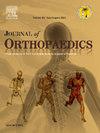无骨铤三锥形骨干用于≥70 岁患者初次全髋关节置换术的短期疗效
IF 1.5
Q3 ORTHOPEDICS
引用次数: 0
摘要
背景全髋关节置换术(THA)后发生假体周围骨折和机械故障在老年患者中并不少见,尤其是在使用无骨水泥植入物的情况下。有领三锥形股骨柄的使用已显示出良好的临床效果,其结果可与其他股骨柄相媲美。关于在老年患者中使用这些股骨柄的文献仍然很少。在这项研究中,我们评估了年龄≥70岁患者使用有领三锥形股骨柄进行初级THA后的术后效果。方法回顾性研究包括2017年9月至2024年7月期间91例年龄≥70岁患者使用三锥形股骨柄进行的初级THA。主要结果包括术中或术后假体周围骨折和股骨柄下沉。通过X光片测量的下沉度为大转子最近端与股骨柄肩部之间的距离。结果 共纳入91名患者,术中或术后均未观察到假体周围骨折。与术后基线成像相比,术后6周的股骨干平均下沉1.1毫米(标准差,0.9)。在该时间点,有三名患者的下沉≥3毫米,但没有明显的临床症状。有一次假体关节感染需要翻修,三次浅表手术部位感染。总体平均随访时间为12.5个月(std dev,12.7)。结论在这项研究中,我们发现在年龄≥70岁的患者中,使用三锥形支架进行初次全人工关节置换术后,下沉率较低,且无假体周围骨折。值得注意的是,没有因机械故障而进行翻修手术。本文章由计算机程序翻译,如有差异,请以英文原文为准。
The short-term outcomes of cementless collared triple-tapered stem for primary total hip arthroplasty in patients ≥70-years old
Background
Periprosthetic fractures and mechanical failure following total hip arthroplasty (THA) are not uncommon occurrences in elderly patients, especially with the use of cementless implants. The utilization of collared, triple-tapered femoral stems has demonstrated good clinical outcomes and results comparable to other femoral stems. There remains a paucity of literature on the use of these stems in older patients. In this study, we evaluated post-operative outcomes following primary THA in patients ≥70-years old using a collared, triple-tapered femoral stem.
Methods
Retrospective study including 91 primary THAs in patients ≥70-years old using a triple-tapered femoral stem, between September 2017 and July 2024. Primary outcomes included intraoperative or post-operative periprosthetic fractures and subsidence of the femoral stem. Subsidence was measured on x-rays as the distance between the most proximal aspect of the greater trochanter and the shoulder of the femoral stem.
Results
A total of 91 patients were included, with no periprosthetic fractures observed intraoperatively or post-operatively. The average femoral stem subsidence at 6-weeks post-operative was 1.1 mm (std dev, 0.9) compared to baseline post-operative imaging. At that time point three patients had subsidence ≥3 mm, with no clinically significant symptoms. There was one prosthetic joint infection requiring revision and three superficial surgical site infections. The overall average follow-up time was 12.5 months (std dev, 12.7).
Conclusion
In this study, we found low rates of subsidence and no periprosthetic fractures following primary THA with triple-taper stems in patients ≥70-years old. Of note, no revision surgeries were performed for mechanical failure.
求助全文
通过发布文献求助,成功后即可免费获取论文全文。
去求助
来源期刊

Journal of orthopaedics
ORTHOPEDICS-
CiteScore
3.50
自引率
6.70%
发文量
202
审稿时长
56 days
期刊介绍:
Journal of Orthopaedics aims to be a leading journal in orthopaedics and contribute towards the improvement of quality of orthopedic health care. The journal publishes original research work and review articles related to different aspects of orthopaedics including Arthroplasty, Arthroscopy, Sports Medicine, Trauma, Spine and Spinal deformities, Pediatric orthopaedics, limb reconstruction procedures, hand surgery, and orthopaedic oncology. It also publishes articles on continuing education, health-related information, case reports and letters to the editor. It is requested to note that the journal has an international readership and all submissions should be aimed at specifying something about the setting in which the work was conducted. Authors must also provide any specific reasons for the research and also provide an elaborate description of the results.
 求助内容:
求助内容: 应助结果提醒方式:
应助结果提醒方式:


